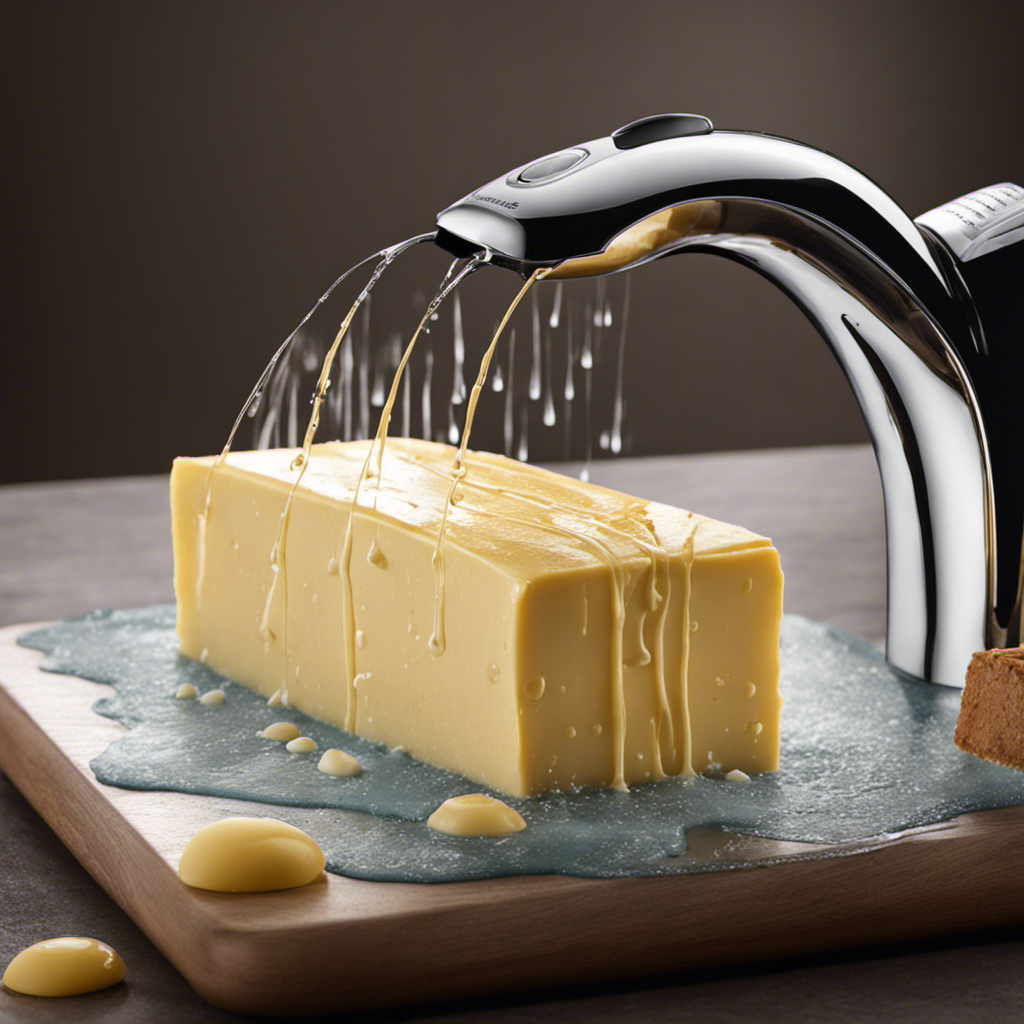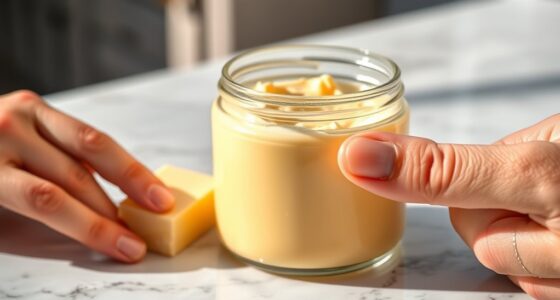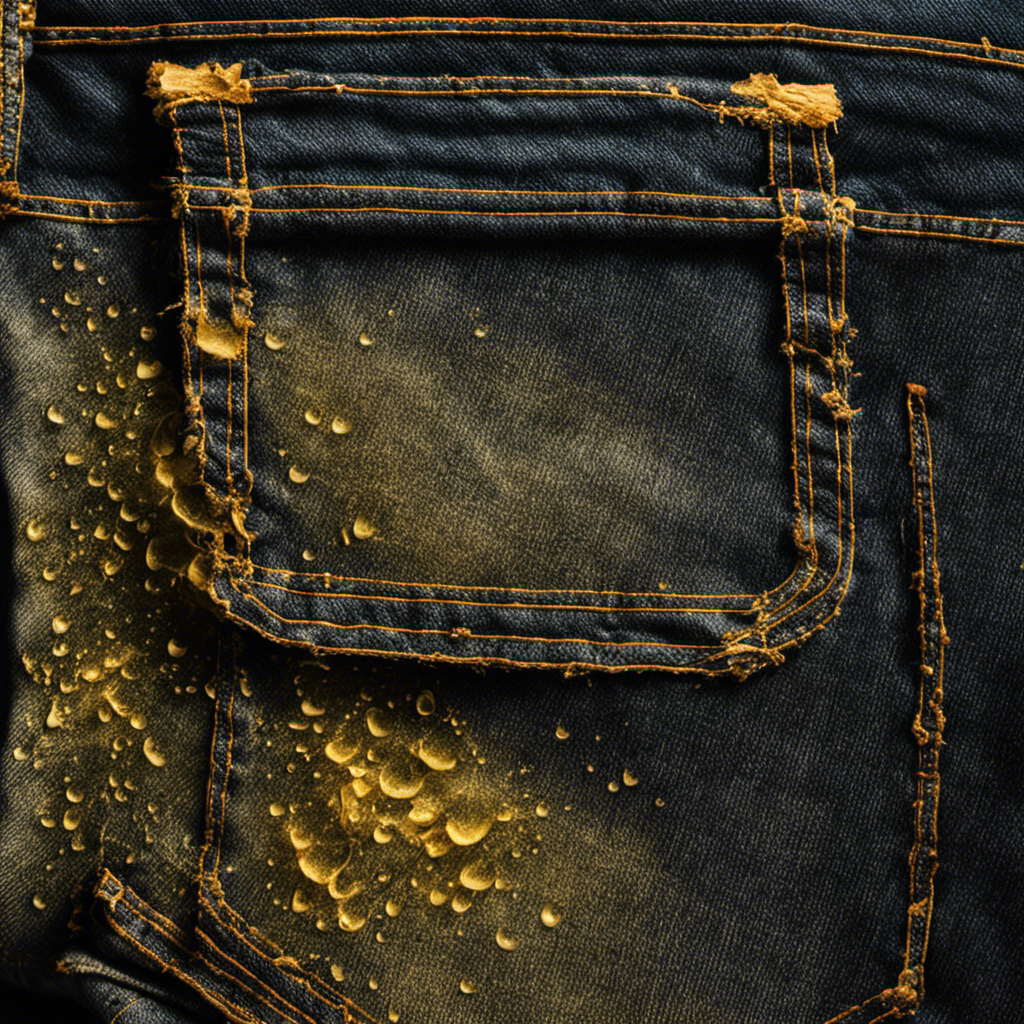As someone who enjoys baking, I have encountered a common issue of forgetting to thaw out butter ahead of time. But don’t worry, my fellow bakers! I have found some reliable ways to defrost frozen butter that will come in handy.
In this article, I’ll share with you the importance of defrosting butter, the right methods to use, and how to properly prepare and defrost your butter. Get ready to say goodbye to rock-hard butter and hello to smooth, spreadable goodness!
Key Takeaways
- Proper defrosting maintains the quality and flavor of butter.
- Softened butter is easier to incorporate into recipes.
- Defrosting butter ensures even distribution of moisture and fat.
- Using defrosted butter prevents lumps in sauces and gravies.
Understanding the Importance of Defrosting Butter
Understanding the importance of defrosting butter is crucial before attempting to use it in recipes.
When butter is frozen, its water content freezes into ice crystals, which can affect the texture and flavor of the butter.
The science behind butter freezing is that when butter is exposed to temperatures below 32°F (0°C), the water molecules in the butter solidify and expand, causing the butter to become hard and brittle.
To prevent butter from getting freezer burn, it is necessary to store it in an airtight container or wrap it tightly in plastic wrap or aluminum foil. This will help to minimize the exposure to air and moisture, which can lead to freezer burn.
Properly defrosting butter is essential to maintain its quality and ensure it blends well with other ingredients in your recipes.
Now that we understand the importance of defrosting butter, let’s explore the different methods available for thawing it.
Choosing the Right Method for Defrosting Butter
When it comes to thawing butter, it’s important to choose the right method for best results.
One popular method is defrosting butter in hot water. To do this, fill a bowl with hot water and place the frozen butter in a sealed ziplock bag. Submerge the bag in the hot water and let it sit for a few minutes until the butter softens.
Another effective method is using a butter dish for defrosting. Simply place the frozen butter in a butter dish and leave it at room temperature for a couple of hours until it softens. This method is convenient if you prefer not to use hot water.
Whether you choose to defrost in hot water or use a butter dish, make sure to check the butter’s consistency periodically to ensure it doesn’t melt too much.
Preparing Butter for Defrosting
To properly prepare butter for thawing, it’s important to consider the right method. Softening butter is a common step in many recipes, and using defrosted butter can be a time-saving solution.
There are a few ways to prepare butter for thawing. One method is to place the frozen butter in the refrigerator overnight. This allows the butter to thaw slowly and evenly.
Another option is to use the defrost setting on a microwave. However, be cautious as this method can lead to uneven softening.
Additionally, using a grater or shredder can help soften frozen butter quickly. Simply grate the frozen butter into small pieces and let it sit at room temperature until softened.
Defrosting Butter at Room Temperature
One option for thawing butter at room temperature is to simply leave it out for a few hours. This method allows the butter to gradually soften and reach its spreadable consistency. However, if you’re in a hurry and need to defrost the butter quickly, there is another method you can try.
To defrost butter quickly, you can place it in a bowl of warm water. Make sure the water is not too hot, as it can melt the butter instead of defrosting it. Keep the butter wrapped in its packaging or a sealed plastic bag to prevent any water from seeping in. Check the butter every few minutes and give it a gentle squeeze to see if it has softened enough.
Defrosting Butter in the Microwave
When it comes to defrosting butter in the microwave, there are a few key points to keep in mind.
First, it’s important to follow the recommended microwave times provided by the manufacturer. This will ensure that the butter thaws evenly and doesn’t become too soft or melted.
Additionally, it’s worth noting that the texture of the butter may change slightly after being defrosted in the microwave, as it can become slightly softer. However, if you prefer a firmer texture, there are alternative defrosting methods that can be used, such as placing the butter in the refrigerator overnight.
Microwave Time Recommendations
The recommended microwave time for defrosting frozen butter is 10-20 seconds. This short time frame allows the butter to soften without melting completely. However, it is important to note that the actual time needed may vary depending on the wattage of your microwave and the size of the butter.
To ensure successful defrosting, here are some butter defrosting hacks to keep in mind:
- Place the frozen butter in a microwave-safe dish.
- Cut the butter into smaller pieces to speed up the defrosting process.
- Use the microwave’s defrost setting or adjust the power level to prevent the butter from melting.
Butter Texture After Defrosting
After defrosting frozen butter in the microwave, it’s important to pay attention to the texture and consistency. The butter may have partially melted during the defrosting process, resulting in a softer and more spreadable consistency. This can be beneficial if you’re planning to use the butter for baking or spreading on bread or toast.
However, if you were hoping for a firmer consistency, you may need to refrigerate the butter for a short period of time to allow it to solidify again. Keep in mind that the texture of butter can vary depending on the brand and type, so it’s always a good idea to check the label for specific instructions.
Ultimately, the goal is to achieve a butter consistency that suits your needs and preferences.
Alternative Defrosting Methods
Microwaving isn’t the only way to thaw butter quickly. You can also use a bowl of warm water or the defrost setting on your toaster oven. These alternative methods are great options when you don’t have a microwave or prefer not to use one.
Here are two alternative methods to defrost frozen butter:
-
Blow Dryer Method
-
Place the frozen butter on a plate or in a bowl.
-
Set your blow dryer to a low heat setting.
-
Hold the blow dryer about 6 inches away from the butter and move it around to evenly distribute the heat.
-
Continue until the butter is soft and easily spreadable.
-
Hot Water Method
-
Fill a bowl with warm water, around 110°F (43°C).
-
Place the frozen butter in a sealed plastic bag and submerge it in the warm water.
-
Let it sit for a few minutes, then check the butter’s consistency.
-
Repeat if needed, until the butter is thawed.
These alternative methods provide convenient and efficient ways to thaw butter without the need for a microwave.
Defrosting Butter in the Fridge
Start by placing the frozen butter in the fridge to defrost it. This method is the most effective and safest way to defrost butter. By allowing the butter to slowly thaw in the fridge, you ensure that it maintains its quality and texture. The cold temperature of the fridge prevents bacteria growth and keeps the butter fresh.
It usually takes around 4 to 6 hours for a stick of butter to completely defrost in the fridge. If you’re in a hurry and need to defrost the butter quickly, you can use the hot water method. Simply place the frozen butter in a sealed plastic bag and submerge it in a bowl of hot water for a few minutes. However, be cautious not to use boiling water as it may melt the butter unevenly.
Frequently Asked Questions
Can I Use Frozen Butter Directly in Baking Recipes Without Defrosting It First?
Yes, you can use frozen butter directly in baking recipes without defrosting it first. However, it is important to properly thaw frozen butter to ensure even distribution and optimal results in your baked goods.
What Is the Best Way to Store Butter After Defrosting It?
The best way to store defrosted butter is in an airtight container in the refrigerator. Alternatively, you can portion it out and freeze it again for future use.
Can I Refreeze Butter After It Has Been Defrosted?
Yes, you can refreeze butter after it has been defrosted, but it’s best to use it immediately to maintain its quality. To thaw butter quickly, leave it at room temperature or use the microwave on low power.
How Long Can Defrosted Butter Be Kept at Room Temperature Before It Goes Bad?
Defrosted butter can be kept at room temperature for up to two weeks. However, it’s important to check for signs of spoilage, such as a rancid smell or mold growth, before using it.
Can I Speed up the Defrosting Process by Placing the Butter in Hot Water?
Placing frozen butter in hot water can help speed up the defrosting process. However, it is important to use caution and ensure the water is not too hot to prevent the butter from melting. There are also alternative methods for defrosting butter.
Conclusion
In conclusion, defrosting frozen butter is a crucial step in ensuring smooth and easy spreading, whether it’s for baking or cooking. By understanding the importance of defrosting and choosing the right method, you can enjoy the full flavor and texture of your butter.
Whether you opt for room temperature, microwave, or fridge defrosting, proper preparation is key. So, next time you find yourself with frozen butter, remember these tips and ask yourself, ‘Why settle for hard and clumpy when you can have perfectly softened butter?’










